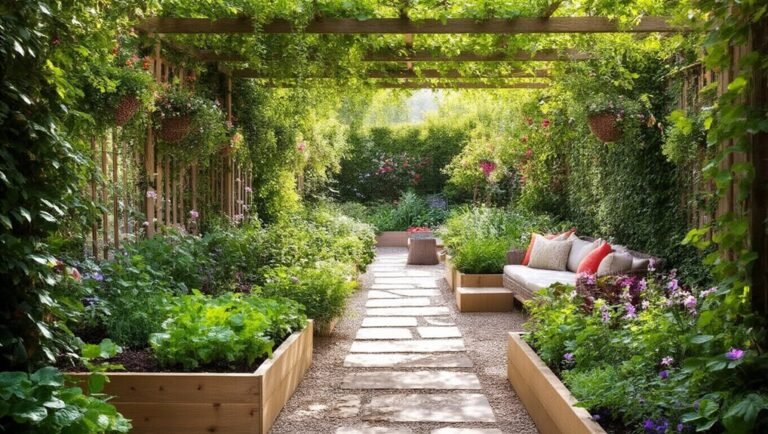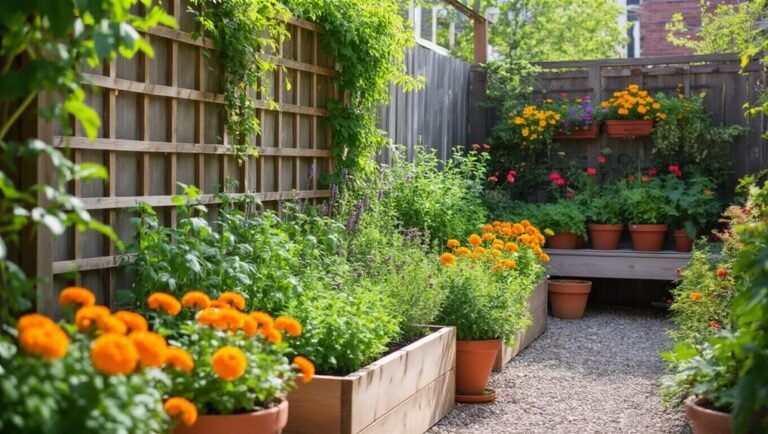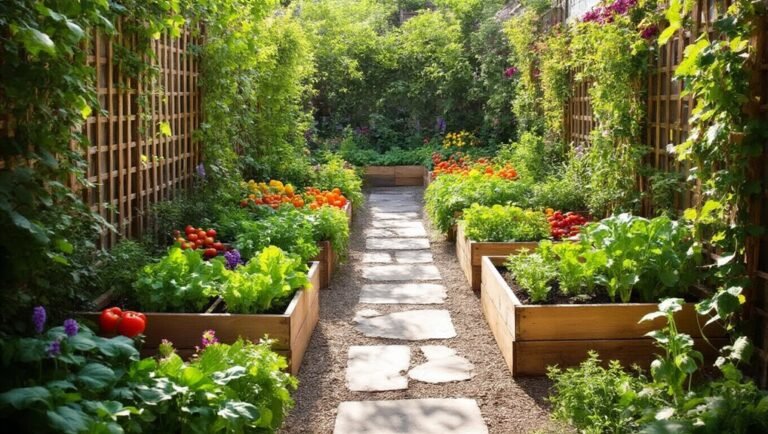To plan the perfect kitchen garden, start by assessing your space and sunlight. Choose plants that thrive in your local climate, like tomatoes and herbs. Design your layout strategically by grouping plants with similar needs and using raised beds for better drainage. Prepare your soil by testing it and adding organic matter. Lastly, care for your garden by checking for pests and watering deeply. There’s more you can learn to make your garden thrive!
Key Takeaways
- Assess sunlight and space to ensure optimal conditions for plant growth and accessibility for maintenance and harvesting.
- Select a variety of herbs and vegetables suited to your climate for continuous harvest throughout the growing season.
- Design a garden layout that groups plants with similar needs and utilizes vertical space with trellis netting for climbing crops.
- Prepare soil by testing pH and nutrients, amending with organic matter, and ensuring a clean and aerated planting area.
- Implement ongoing care practices, including regular pest checks, deep watering, and timely harvesting for peak flavor and plant health.
Assessing Your Space and Sunlight
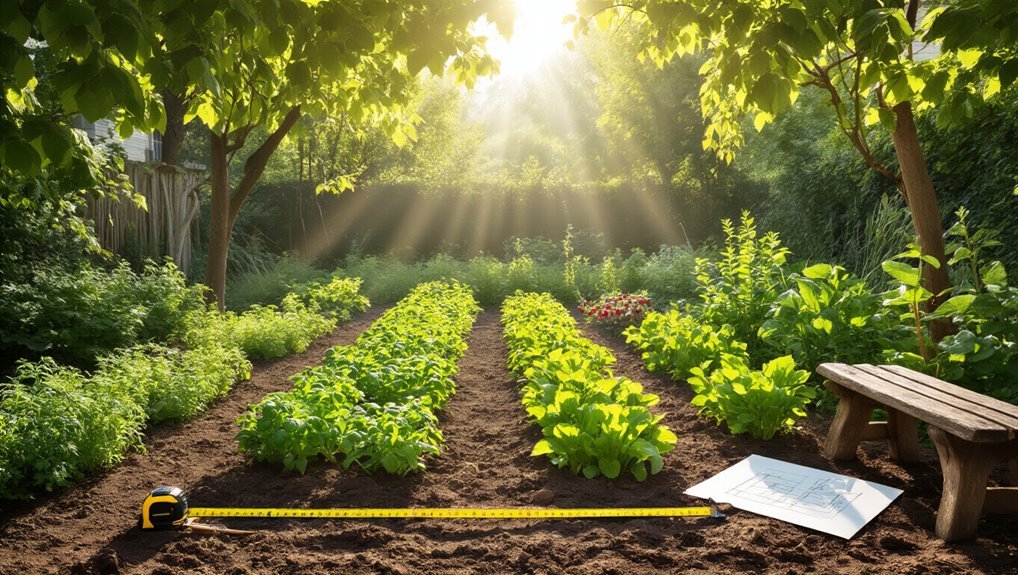
Before you dig into your kitchen garden plans, take a moment to assess your space and sunlight. Look around your yard or balcony and identify the areas that receive the most sunlight throughout the day.
Ideally, you want at least six hours of direct sunlight for most vegetables and herbs. Next, measure the available space; it helps to visualize how many plants you can fit comfortably. Using a garden sprinkler timer can help automate your watering schedule and ensure your plants receive consistent moisture.
Consider obstacles like trees, fences, or buildings that may cast shadows. Also, think about accessibility—make sure you can reach your plants easily for watering and harvesting.
If you want to make watering easier and more efficient, consider using garden sprinklers to keep your plants healthy and hydrated.
Choosing the Right Plants for Your Kitchen Garden
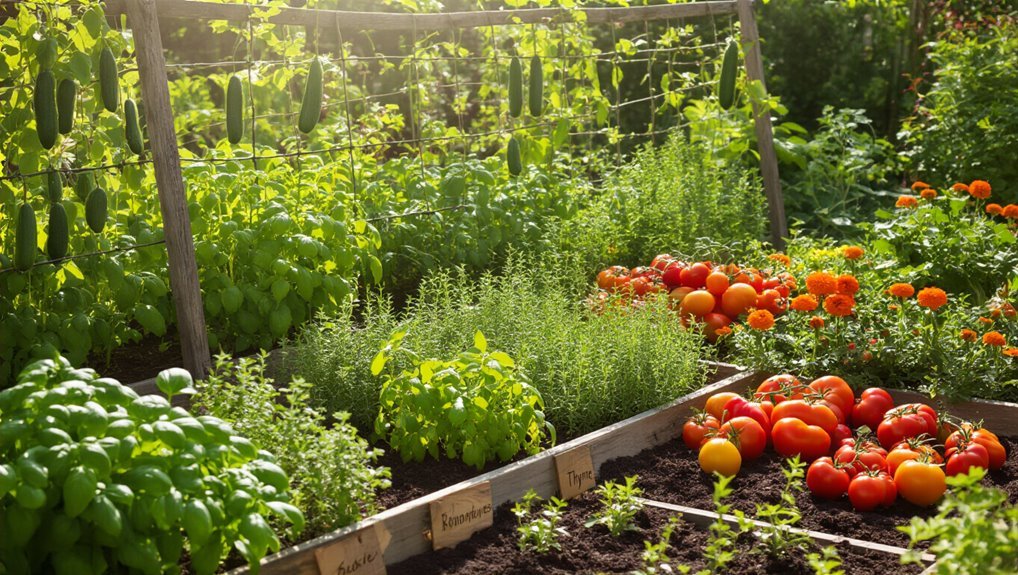
How do you decide which plants to include in your kitchen garden? Start by considering what you enjoy cooking with. Herbs like basil, cilantro, and parsley are easy to grow and can elevate your dishes. You can also simplify the process by starting with herb garden kits, which come with seeds and pots to get you growing right away.
Next, think about vegetables that thrive in your climate. Tomatoes, peppers, and lettuce are popular choices that can be used in various recipes. Make sure to check the growing conditions and space requirements for each plant.
Choose a mix of fast-growing crops and those that take longer to mature, so you can enjoy fresh produce throughout the season. Finally, don’t forget to include some flowers to attract pollinators, enhancing both beauty and productivity in your garden.
You might also want to add insect repellent plants such as citronella to naturally help protect your garden from pests while keeping it chemical-free.
Happy planting!
Designing Your Garden Layout
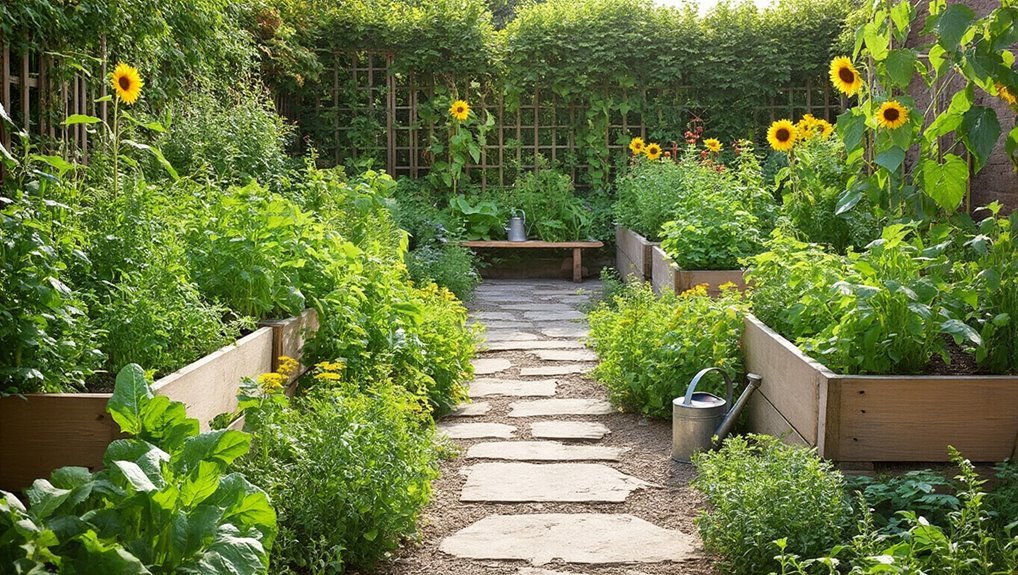
Once you’ve chosen the right plants for your kitchen garden, the next step is to design an efficient layout. Start by sketching a rough plan of your garden space.
Consider sun and shade patterns, as most vegetables thrive in full sunlight. Group plants with similar watering and sunlight needs together to simplify maintenance. To support climbing vegetables and maximize yield, consider using quality trellis netting, which offers both structure and increased growing space.
Use raised beds or containers if space is limited; they can improve drainage and yield. Raised beds are especially beneficial because elevate your gardening by making it easier to control soil quality and reduce weed growth. Keep pathways wide enough for easy access and maintenance.
Think about vertical gardening options like trellises for climbing plants, maximizing your space. Lastly, leave room for future expansion, as you might want to try new plants or varieties.
A well-planned layout can make your garden both functional and visually appealing.
Soil Preparation and Maintenance
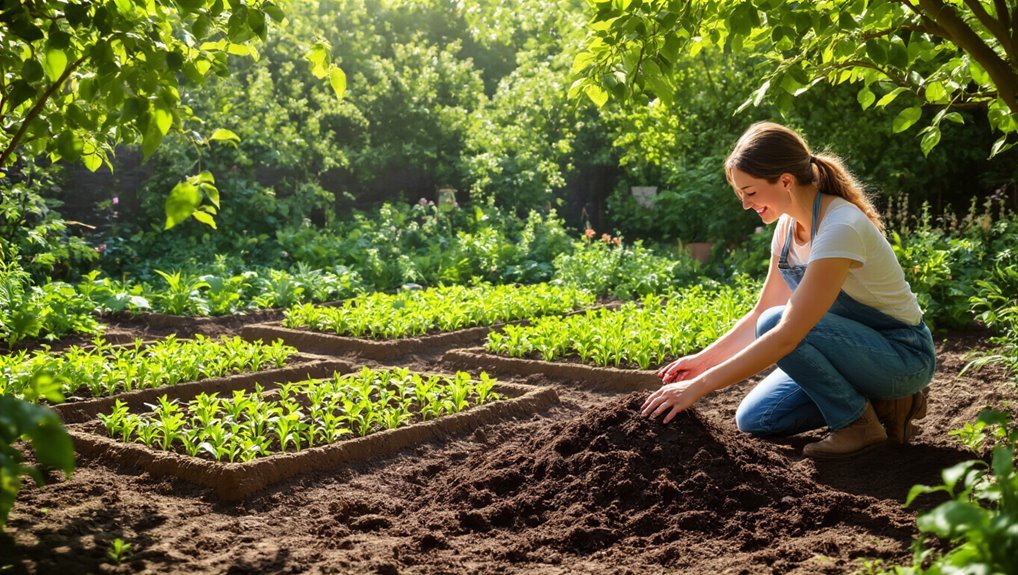
Soil preparation is crucial for a thriving kitchen garden, as healthy soil provides the foundation for robust plant growth.
Start by testing your soil to determine its pH and nutrient levels. Based on the results, you can amend the soil with organic matter like compost or aged manure to improve its structure and fertility. Using mulch can further enhance soil quality by helping to regulate temperature and reduce erosion.
Remove any weeds, rocks, or debris to create a clean planting area. Tilling the soil helps aerate it, promoting better root development.
If your soil is heavy clay or sandy, consider adding materials to improve drainage or moisture retention. Regularly check soil moisture and ensure it stays consistent.
For added protection and improved soil health, consider using organic mulching materials such as straw to help retain moisture, suppress weeds, and enrich the soil as they break down.
Tips for Ongoing Care and Harvesting
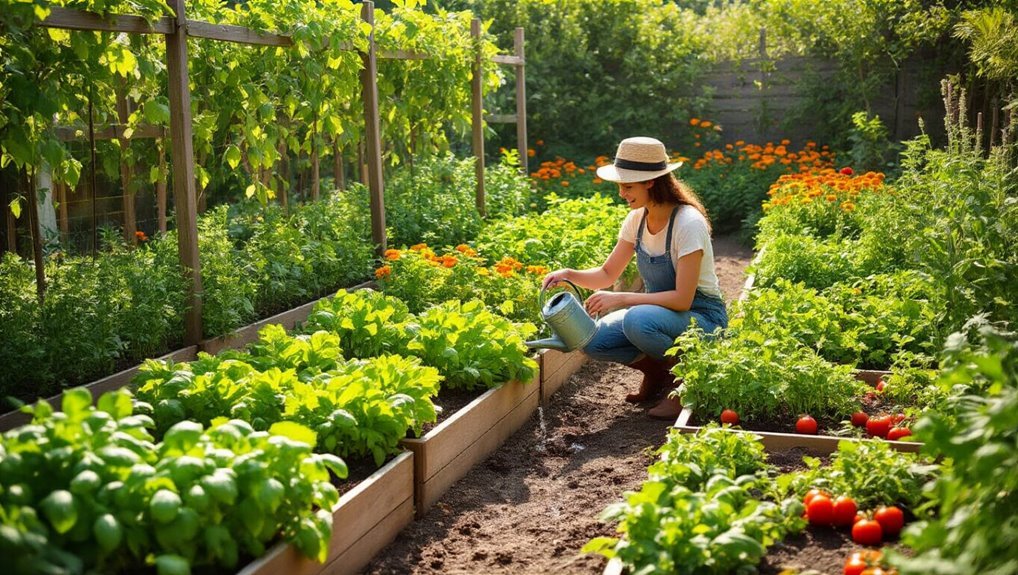
As you nurture your kitchen garden, ongoing care and timely harvesting are key to maximizing your yield and enjoying fresh produce.
Regularly check for pests and diseases; early detection makes a huge difference. Water your plants deeply but infrequently to promote strong root growth. Mulching can help retain moisture and suppress weeds.
When it comes to harvesting, pick fruits and vegetables at their peak ripeness for the best flavor. For leafy greens, harvest outer leaves first to encourage continued growth.
Always use clean, sharp tools to minimize damage to the plants. Lastly, keep a gardening journal to track what works and what doesn’t, helping you improve your garden year after year.
Happy gardening!
Frequently Asked Questions
What Tools Do I Need to Start a Kitchen Garden?
You’ll need basic tools like a trowel, garden fork, pruning shears, and a watering can. Gloves and a rake will help, too. With these, you’re ready to dig in and start your garden!
How Much Water Do Kitchen Garden Plants Need?
Most garden plants need about an inch of water weekly. You’ll want to check the soil moisture regularly, ensuring it’s neither too dry nor overly saturated, as both extremes can hinder your plants’ growth.
Can I Grow a Kitchen Garden in Containers?
Yes, you can definitely grow a kitchen garden in containers! Just choose the right plants, ensure proper drainage, and provide adequate sunlight and water. You’ll enjoy fresh herbs and vegetables right from your patio or balcony.
How Do I Protect My Garden From Pests?
Imagine your garden as a fortress; to guard it from pests, you’ll build barriers. Use companion plants, introduce beneficial insects, and apply natural repellents. These tactics’ll keep your crops safe and thriving throughout the season.
What Are the Best Companion Plants for a Kitchen Garden?
For your kitchen garden, consider planting basil with tomatoes for flavor enhancement, or marigolds to deter pests. Pairing these plants not only boosts growth but also creates a vibrant, productive environment in your garden.
Conclusion
As you dig into your kitchen garden, you’ll find it’s more than just a source of fresh produce; it’s a journey. Each seed you plant connects you to the earth and the meals you’ll create. Just as you nurture your plants, they’ll nurture you, providing joy and health in unexpected ways. So, embrace the process, and watch as your little patch of earth transforms into a vibrant haven, proving that the best flavors often come from your own hands.
